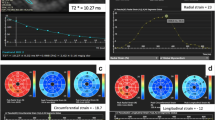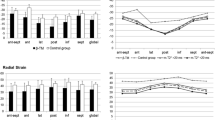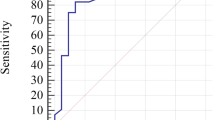Abstract
Iron-overload cardiomyopathy is the principal cause of mortality in thalassemia. Via feature-tracking cardiac magnetic resonance (FT-CMR), we investigated alterations in cardiac deformation with the progression in myocardial iron overload (MIO). We enrolled 154 patients with thalassemia (50.64% male, mean age = 32.19 ± 9.79 years) referred for MIO assessment and 28 controls (50% male, mean age = 31.07 ± 4.35 years). Functional, strain, and T2* values were assessed in 4 study groups: no MIO (T2* > 20), mild-to-moderate MIO (T2* = 10–20), severe MIO (T2* < 10), and healthy controls. The recorded strain values were compared between the groups. The study groups were statistically significantly different vis-à-vis left ventricular (LV) global longitudinal strain (GLS) (F [3, 178] = 20.30), LV global radial strain (GRS) (F [3, 178] = 11.61), right ventricular (RV) GLS (F [3, 178]) = 5.32), RV global circumferential strain (GCS) (F [3, 178] = 26.02), and RVGRS (F [3, 178] = 16.86) (Ps < 0.005). The post hoc test revealed that LVGLS, RVGCS, and RVGRS were different between patients with thalassemia but without MIO and the control group (Ps < 0.001). A significant difference in LVGLS and LVGRS was detected between the T2* > 20 and 10 ≤ T2* ≤ 20 groups (Ps < 0.05). The multivariate logistic regression analysis depicted LVGRS as the most robust predictor of MIO (T2* ≤ 20) (odds ratio = 0.920, 95% CI 0.886 to 0.955), which predicted MIO with a cutoff point of 31.16% or less (sensitivity = 62% and specificity = 80.77%). Biventricular FT-CMR values are impaired in patients with thalassemia even without MIO. With MIO progression, LV strain values are the first ones to be undermined. Notably, functional CMR indices are jeopardized late, only after severe iron deposition.





Similar content being viewed by others
Data availability
The data sets used during the current study are available from the corresponding author upon reasonable request.
Code availability
All codes are available.
References
Weatherall DJ, Clegg JB (2008) The thalassemia syndromes. Wiley, Oxford
Lewis BS, Rachmilewitz EA, Amitai N, Halon DA, Gotsman MS (1978) Left ventricular function in β-thalassemia and the effect of multiple transfusions. Am Heart J 96(5):636–645
Kremastinos DT, Tsiapras DP, Tsetsos GA, Rentoukas EI, Vretou HP, Toutouzas PK (1993) Left ventricular diastolic Doppler characteristics in beta-thalassemia major. Circulation 88(3):1127–1135
Pennell DJ, Udelson JE, Arai AE, Bozkurt B, Cohen AR, Galanello R, Hoffman TM, Kiernan MS, Lerakis S, Piga A (2013) Cardiovascular function and treatment in β-thalassemia major: a consensus statement from the American Heart Association. Circulation 128(3):281–308
Forget B, Pearson H (1995) Hemoglobin synthesis and the thalassemias. In: Handin R, Lux S, Stoesel T (eds) Blood: principles and practice of hematology. JB Lippincott, Philadelphia, p p1525
Chitiboi T, Axel L (2017) Magnetic resonance imaging of myocardial strain: a review of current approaches. J Magn Reson Imaging 46(5):1263–1280
Kwiatkowski JL, Kim H-Y, Thompson AA, Quinn CT, Mueller BU, Odame I, Giardina PJ, Vichinsky EP, Boudreaux JM, Cohen AR (2012) Chelation use and iron burden in North American and British thalassemia patients: a report from the Thalassemia Longitudinal Cohort. Blood J Am Soc Hematol 119(12):2746–2753
Origa R, Danjou F, Cossa S, Matta G, Bina P, Dessì C, Defraia E, Foschini ML, Leoni G, Morittu M (2013) Impact of heart magnetic resonance imaging on chelation choices, compliance with treatment and risk of heart disease in patients with thalassemia major. Br J Haematol 163(3):400–403
Pryds K, Larsen AH, Hansen MS, Grøndal AYK, Tougaard RS, Hansson NH, Clemmensen TS, Løgstrup BB, Wiggers H, Kim WY (2019) Myocardial strain assessed by feature tracking cardiac magnetic resonance in patients with a variety of cardiovascular diseases—a comparison with echocardiography. Sci Rep 9(1):1–9
Bijnens BH, Cikes M, Claus P, Sutherland GR (2009) Velocity and deformation imaging for the assessment of myocardial dysfunction. Eur J Echocardiogr 10(2):216–226
Rezaeian N, Mohtasham MA, Khaleel AJ, Parnianfard N, Kasani K, Golshan R (2020) Comparison of global strain values of myocardium in beta-thalassemia major patients with iron load using specific feature tracking in cardiac magnetic resonance imaging. Int J Cardiovasc Imaging 36(7):1343–1349
Monte I, Buccheri S, Bottari V, Blundo A, Licciardi S, Romeo MA (2012) Left ventricular rotational dynamics in Beta thalassemia major: a speckle-tracking echocardiographic study. J Am Soc Echocardiogr 25(10):1083–1090
Piccione MC, Piraino B, Zito C, Khandheria BK, Di Bella G, De Gregorio C, Oreto L, Rigoli L, Ferraù V, Salpietro CD (2013) Early identification of cardiovascular involvement in patients with β-thalassemia major. Am J Cardiol 112(8):1246–1251
Sengupta PP, Narula J (2008) Reclassifying heart failure: predominantly subendocardial, subepicardial, and transmural. Heart Fail Clin 4(3):379–382
Wang ZJ, Fischer R, Chu Z, Mahoney DH Jr, Mueller BU, Muthupillai R, James EB, Krishnamurthy R, Chung T, Padua E (2010) Assessment of cardiac iron by MRI susceptometry and R2* in patients with thalassemia. Magn Reson Imaging 28(3):363–371
Ghugre NR, Enriquez CM, Gonzalez I, Nelson MD Jr, Coates TD, Wood JC (2006) MRI detects myocardial iron in the human heart. Magn Reson Med Off J Int Soc Magn Reson Med 56(3):681–686
Olson LJ, Edwards WD, McCall JT, Ilstrup DM, Gersh BJ (1987) Cardiac iron deposition in idiopathic hemochromatosis: histologic and analytic assessment of 14 hearts from autopsy. J Am Coll Cardiol 10(6):1239–1243
Fraidenburg DR, Machado RF (2016) Pulmonary hypertension associated with thalassemia syndromes. Ann N Y Acad Sci 1368(1):127
Sukmawan R, Watanabe N, Akasaka T, Neishi Y, Izumi R, Kawamoto T, Yoshida K (2005) Automatic quantification of left ventricular systolic wall thickening using two-dimensional strain assessed by a novel tissue-tracking system. J Echocardiogr 3(1):27–32
MacIver DH, Townsend M (2008) A novel mechanism of heart failure with normal ejection fraction. Heart 94(4):446–449
Gujja P, Rosing DR, Tripodi DJ, Shizukuda Y (2010) Iron overload cardiomyopathy: better understanding of an increasing disorder. J Am Coll Cardiol 56(13):1001–1012
Magri D, Sciomer S, Fedele F, Gualdi G, Casciani E, Pugliese P, Losardo A, Ferrazza G, Pasquazzi E, Schifano E (2008) Early impairment of myocardial function in young patients with β-thalassemia major. Eur J Haematol 80(6):515–522
Parsaee M, Saedi S, Joghataei P, Azarkeivan A, Alizadeh Sani Z (2017) Value of speckle tracking echocardiography for detection of clinically silent left ventricular dysfunction in patients with β-thalassemia. Hematology 22(9):554–558
Seldrum S, Pierard S, Moniotte S, Vermeylen C, Vancraeynest D, Pasquet A, Vanoverschelde J-L, Gerber BL (2011) Iron overload in polytransfused patients without heart failure is associated with subclinical alterations of systolic left ventricular function using cardiovascular magnetic resonance tagging. J Cardiovasc Magn Reson 13(1):23
Chen MR, Ko HS, Chao TF, Liu HC, Kuo JY, Bulwer BE, Yeh HI, Hung CL (2015) Relation of myocardial systolic mechanics to serum ferritin level as a prognosticator in thalassemia patients undergoing repeated transfusion. Echocardiography 32(1):79–88
Hershko C (2010) Pathogenesis and management of iron toxicity in thalassemia. Ann N Y Acad Sci 1202(1):1–9
Funding
None.
Author information
Authors and Affiliations
Contributions
All authors contributed in data gathering and writing the article
Corresponding author
Ethics declarations
Conflict of interest
All the authors confirm that they have no conflicts of interest.
Ethical approval
All the procedures performed in this study were in keeping with the ethical standards of the Institutional Research Committee of Iran University of Medical Sciences and the 1964 Helsinki Declaration and its later amendments or comparable ethical standards.
Informed consent
Informed consent was obtained from all the individual participants included in the study for publication of the research.
Additional information
Publisher’s Note
Springer Nature remains neutral with regard to jurisdictional claims in published maps and institutional affiliations.
Rights and permissions
About this article
Cite this article
Asadian, S., Rezaeian, N., Hosseini, L. et al. How does iron deposition modify the myocardium? A feature-tracking cardiac magnetic resonance study. Int J Cardiovasc Imaging 37, 3269–3277 (2021). https://doi.org/10.1007/s10554-021-02305-0
Received:
Accepted:
Published:
Issue Date:
DOI: https://doi.org/10.1007/s10554-021-02305-0




